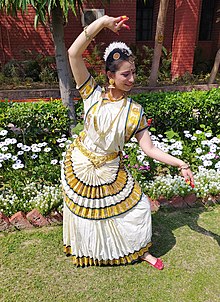Lasya

Lasya(Sanskrit:लास्य,romanized:Lāsya) is a female dance form that originated inIndia.[1]InHindu mythology,Lasya refers to the dance innovated and performed by the goddessParvati,described to be gentle and graceful.[2]Described in theNatya Shastra,the feminine Lasya danced by Parvati is contrasted by the masculineTandavadance of her consort,Shiva.[3][4]
Etymology[edit]
The termlāsyais derived from the root ‘las’ meaning to play or to frolic. It is also translated as lively.[5]
Legend[edit]
According to legend, the Lasya was taught by Parvati toUsha,the daughter ofBanasura.[6]Usha, in turn, is regarded to have taught the dance to the milkmaids known as thegopikas,who are believed to have spread the technique to women throughout the land.[7]
Description[edit]
Described as the prototype of all female dancing, the Lasya is danced in a variety of forms, most of which comprise the small and seductive motions of the feet. Some forms of the Lasya consist of the rapid succession of minor steps, regarded to be erotic. During the performance of the dance, the feet are kept parallel and close to one another, each foot following the other with precision in time. An example of this dance is theMohiniyattamofKerala.[8]
There are described to be four forms of the Lasya: Srinkhala, Lata, Pindi, and Bhedyaka.[9]
ProfessorInayat Khanin his bookMunqar Musicar(1912) wrote: "Women and men both perform this dance and there are a number of recognized masters (ustad) of it in India. Lasya is accompanied by two sarangi players and a tabid, and sometimes amanjira(small indian cymbals). It is danced by one woman, or by two together ".[10]
References[edit]
- ^Arnold, Alison (2017-09-25).The Garland Encyclopedia of World Music: South Asia: The Indian Subcontinent.Routledge. p. 749.ISBN978-1-351-54438-2.
- ^Bose, Mandakranta (2012-12-06).Movement and Mimesis: The Idea of Dance in the Sanskritic Tradition.Springer Science & Business Media. p. 152.ISBN978-94-011-3594-8.
- ^Masson-Ousel, P.; Stern, P.; Willman-Grabowska, H. (2013-10-11).Ancient India and Indian Civilization.Routledge. p. 375.ISBN978-1-136-20072-4.
- ^Ganguly, Anil Baran (1979).Fine Arts in Ancient India.Abhinav Publications. p. 78.
- ^Subramuniya (Master.) (2000).How to Become a Hindu: A Guide for Seekers and Born Hindus.Himalayan Academy Publications. p. 368.ISBN978-0-945497-82-0.
- ^Vatsyayan, Kapila (1974).INDIAN CLASSICAL DANCE.Publications Division Ministry of Information & Broadcasting. p. 40.ISBN978-81-230-2957-3.
- ^Shivaji, Bharati; Pasricha, Avinash (1986).The Art of Mohiniyāttam.Lancer Publishers. p. 6.ISBN978-81-7062-003-7.
- ^Walker, Benjamin (2019-04-09).Hindu World: An Encyclopedic Survey of Hinduism. In Two Volumes. Volume I A-L.Routledge. p. 304.ISBN978-0-429-62421-6.
- ^Bhagyalekshmy, S.Approach to Bharatanatyam.p. 5.
- ^Hazrat Inayat Khan. «The Minqar-i Musiqar: Hazrat Inayat Khan's Classic 1912 Work on Indian Musical Theory and Practice». Omega Publications. 2016 (ISBN1941810187)
